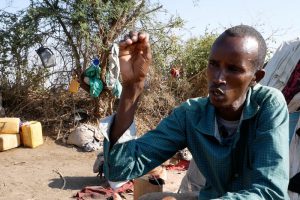A deadly epidemic disease that slows livestock weight gain, reduces milk and meat production, and causes infertility and abortion has infested South central Somalia.
The tsetse fly lives along the rivers Shabelle and Juba where it thrives in the region’s trees, bushes and high humidity. The fly is a carrier of trypanosomiasis disease, which has a devastating impact on the region’s livestock and economy.
In Balcad town, the pests are threatening livestock and the livelihoods of the pastoral communities who take their cattle to the Shabelle River there. The river is the lifeline for agriculture and agro-pastoralists who produce cotton, maize, fruits and vegetables in the town. However, it is during the rainy season that the flies thrive and breed in larger numbers.
‘’We have changed our grazing timings from day to night hours due to the increase of the deadly insect,” says 39-year-old Mohammed Adow Diisow, who is a pastoralist in Bula Burwaqo, Balcad town. “The riverbank is prone to tsetse flies and our major challenge is this disease (trypanosomiasis), which kills our livestock.”
Livestock specialists with the International Committee of the Red Cross (ICRC) have trained the community animal health workers in livestock disease control. Through installation of NGU-type traps and pour-on treatment, the number of tsetse flies in the area has drastically reduced. The traps are made of blue and black cloth that attract the flies. Cow urine is also used to draw them in.
“We have reached our target in controlling the tsetse flies by installing 2,000 traps and treating more than 500,000 cattle in the riverine areas,” says Massimo Zecchini, ICRC’s livestock specialist in Somalia. “The local community are aware of the importance of the external parasites control and they are participating in the monitoring of the traps.”
Why are we trapping tsetse fly in #Somalia? pic.twitter.com/3ioz44bf7V
— ICRC Africa (@ICRC_Africa) June 19, 2017
The traps are a long-term sustainable solution for the community in the riverine areas. The control of the flies has benefited the community through increasing livestock production and improving animal health. This, in turn, has secured the economics of pastoral and agro-pastoral livelihoods in the area.
Since January, the ICRC has assisted more than a million drought affected people across Somalia by providing them with food, cash, and healthcare. It has also rehabilitated water points to ensure families have increased access for themselves and their animals. In parallel to the emergency drought response, the ICRC continues to implement livelihood related interventions such tsetse control, improving veterinary services, provision of productive inputs and trainings to the farming, pastoral and fishing communities.

The disease (trypanosomiasis) transmitted by the tsetse fly reduces the milk and meat production in livestock. In Balcad town, the number of tsetse flies has reduced due to the installation of NGU traps. © ICRC/Abdikarim Mohamed



